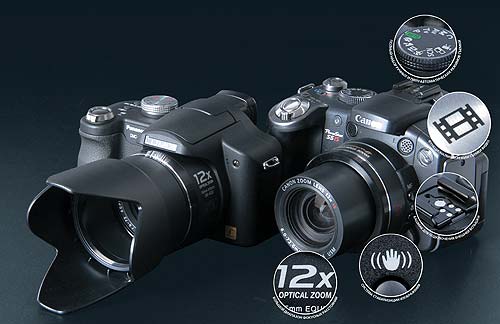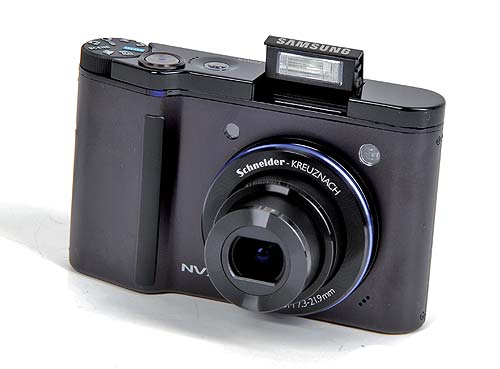Test of mid-range digital cameras
15.11.07
Today, the most advanced and functional cameras of the non-mirror type can be conventionally divided into two categories. The first and largest are top models of ultrazooms from various manufacturers. Representatives of the second category – cameras with really wide capabilities and functions, but not such a wide range of focal lengths, are presented more modestly. For example, these are the G series models from Canon and the P5000/P5100 from Nikon. By the way, the choice between cameras of these categories is not as obvious as it might seem.
Of course, the ability to shoot a distant object close-up is very attractive and makes the ultrasound very versatile in use. But it should be noted that to develop a lens with a large zoom (the zoom value is the ratio of the maximum focal length to the minimum), which works equally well at all focal lengths (resolution, chromatic aberrations, resistance to glare, geometry, etc.). ), quite complicated and expensive, so in most ultrazooms we can observe a rather modest 1/2.5” matrix (not 1/1.8”), for which it is easier and cheaper to construct a lens. This negatively affects some characteristics of the resulting image, as far as noise is concerned.

Both types cannot be called compact cameras. But in this class of devices, this is rather a plus. After all, working with such cameras is very convenient. Many devices also have a comfortable grip, thanks to a special protrusion-handle on the body. Another feature of these cameras is a large number of different control buttons. Having understood their purpose, you can make the shooting process much more comfortable and efficient. After all, it is easier to press the appropriate button than to go to the settings menu every time. As for the shooting devices, there is also complete order here.
Various modes of exposure control, manual focus, white balance adjustment, exposure metering, flash control and other features are available in cameras of this class. If you are starting to get acquainted with photography – a full set of presets for all kinds of shooting situations (portrait, twilight, sports, etc.) is available at your service. It is also logical to expect from these cameras and a large screen of high resolution, and some models can boast of a rotating screen.
By the way, it should be noted that progress does not stand still, and in terms of efficiency, today’s participants have noticeably added compared to the models of previous generations. Zooming in some cameras is very fast, even despite the large zoom value. The new models are distinguished by quite clever autofocus.
Various “utilities”
With a lack of lighting, there is a high probability that the pictures may turn out smeared. This is especially true when shooting at long focal lengths. Image stabilization technology is designed to combat this problem. It should be noted that in many models it is really effective. At the same time, do not forget that you can benefit from its use only when shooting static scenes. The operation of the stabilization system in the cameras being tested will be discussed in more detail in the test.
Although the main purpose of these devices is to take photos, they do not save when recording videos. In addition to a significant resolution of 640×480 pixels, and sometimes more, at a speed of 30 fps, many models allow you to zoom right in while shooting and can refocus depending on the location of the object being shot. And the Canon PowerShot S5 IS camera is generally capable of recording with stereo sound.
According to the number of pixels of the light-receiving matrix, the participants set new records. Unfortunately, this is no longer crucial. No one canceled the laws of physics, and for the matrices that are installed in these cameras, the milestone has long been overcome, and the further increase in their number is pointless, because it is “eaten” by diffraction and the resolution does not increase. So just ignore the number of megapixels in these cameras.
Cameras are different
Today there are a large number of cameras with sometimes very unexpected properties and functions. It is difficult for these devices to compete on equal terms with the main participants of the test in terms of image quality, but we were interested in considering these cameras as well. As part of our test, they are in a separate category (these models are presented in the table on p. 62) and the method of their evaluation differs in many respects. Conventionally, we will call these image devices (you can’t call them affordable – their cost reaches $400, and sometimes more), while they can have a non-standard, bright design, excellent performance and case materials.
For the benefit of the user, they are often endowed with unusual properties. For example, the Panasonic TZ3 and Casio V7 cameras have a special lens design with a periscopic placement of lenses (the optical axis of these lenses is bent by 90 degrees, which allows the cameras to be equipped with lenses with a wide range of focal lengths, while the cameras remain quite compact sizes). The HP R937 has a huge 3.6-inch touchscreen, and our recent review of the Sony DSC-G1 (hi-Tech PRO 9/2007, p. 39) boasts wireless Wi-Fi.
To be or not to be?
In terms of cost, cameras in this class are sometimes very close to entry-level SLR cameras, and some models directly compete with them on price. But still, it is not quite correct to compare these cameras. They have different users. If you do not have too high demands on image quality, are not ready to continue spending money on new components for your camera, but want a camera “for all occasions” – universal, functional, convenient, then the cameras presented in our testing are for you will be very interesting.
Full version of the article in PDF format >>
Web-droid editor
Don't miss interesting news
Subscribe to our channels and read announcements of high-tech news, tes
Oppo A6 Pro smartphone review: ambitious

Creating new mid-range smartphones is no easy task. Manufacturers have to balance performance, camera capabilities, displays, and the overall cost impact of each component. How the new Oppo A6 Pro balances these factors is discussed in our review.
Editor’s Choice 2025. Best devices of the year by hi-tech.ua

The best gaming laptops, mice for work, gaming keyboards, smartphones, and wireless headphones of 2025. Among them, we will highlight the most interesting ones and those that we can recommend buying.
YouTube will be completely blocked in russia YouTube
Russian authorities continue to restrict citizens’ access to independent sources of information. After blocking Instagram, Facebook, WhatsApp, Discord, Viber, and even the game Roblox
EU will not ban internal combustion engine cars after 2035 car law
European Union has revised its approach to regulating the sale of cars with internal combustion engines and abandoned the idea of a complete ban.






